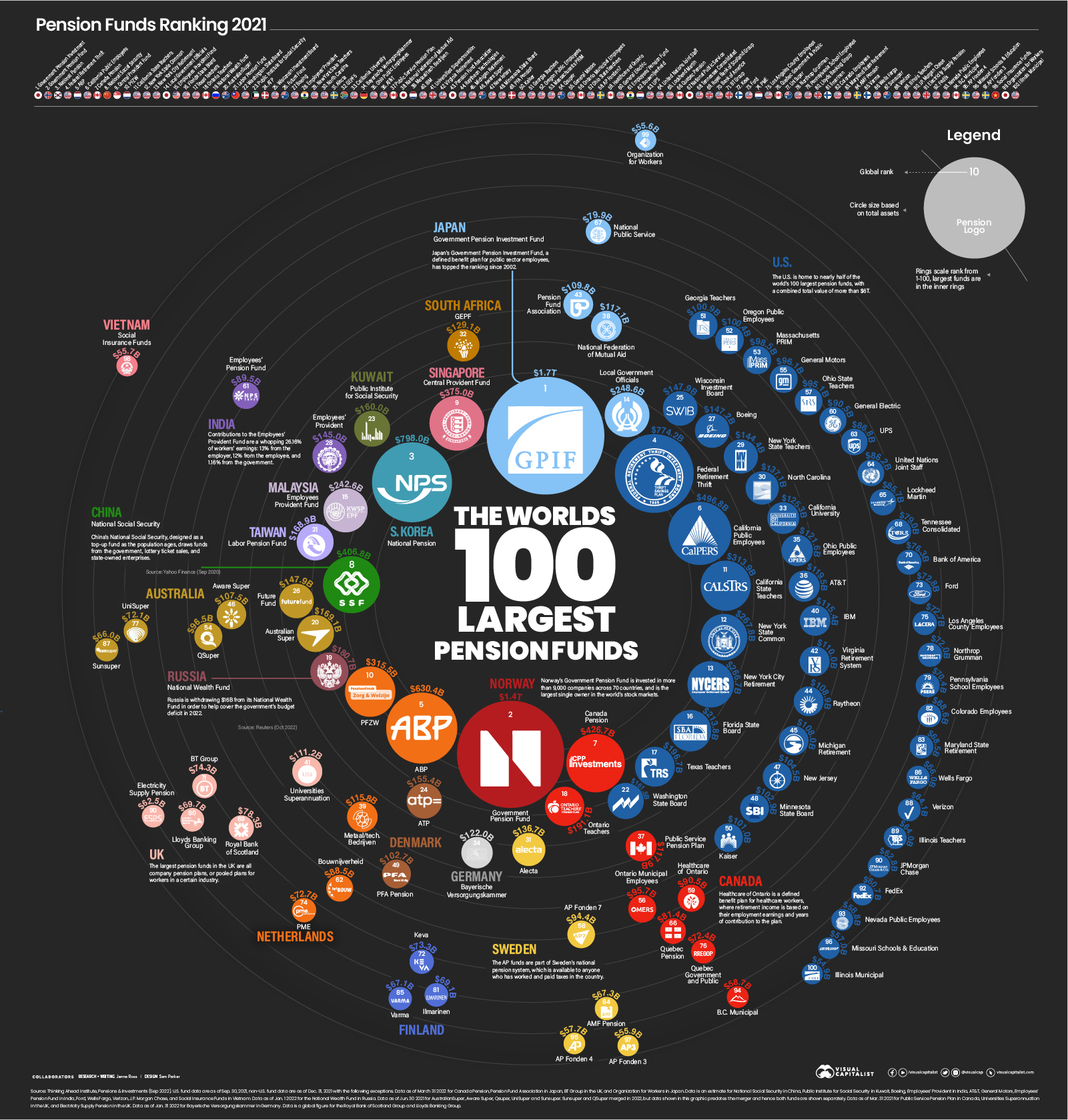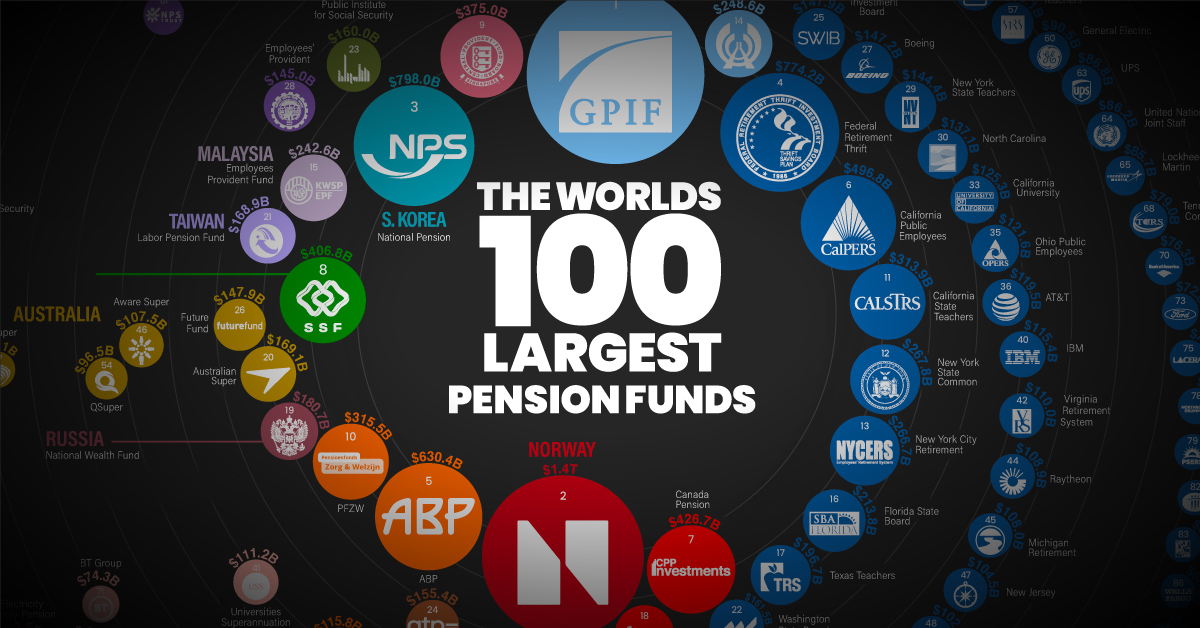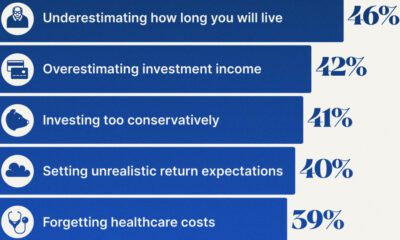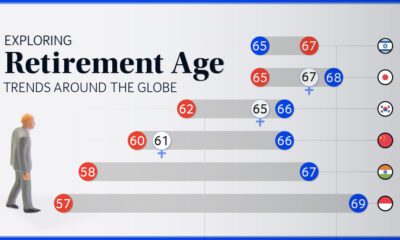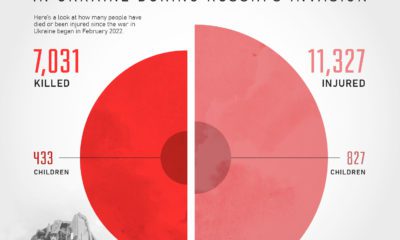Markets
Ranked: The World’s 100 Biggest Pension Funds
View the full-resolution version of this infographic
Ranked: The World’s 100 Biggest Pension Funds
View the high-resolution of the infographic by clicking here.
Despite economic uncertainty, pension funds saw relatively strong growth in 2021. The world’s 100 biggest pension funds are worth over $17 trillion in total, an increase of 8.5% over the previous year.
This graphic uses data from the Thinking Ahead Institute to rank the world’s biggest pension funds, and where they are located.
What is a Pension Fund?
A pension fund is a fund that is designed to provide retirement income. This ranking covers four different types:
- Sovereign funds: Funds controlled directly by the state. This ranking only includes sovereign funds that are established by national authorities.
- Public sector funds: Funds that cover public sector workers, such as government employees and teachers, in provincial or state sponsored plans.
- Private independent funds: Funds controlled by private sector organizations that are authorized to manage pension plans from different employers.
- Corporate funds: Funds that cover workers in company sponsored pension plans.
Among the largest funds, public sector funds are the most common.
The Largest Pension Funds, Ranked
Here are the top 100 pension funds, organized from largest to smallest.
| Rank | Fund | Market | Total Assets |
|---|---|---|---|
| 1 | Government Pension Investment Fund | 🇯🇵 Japan | $1.7T |
| 2 | Government Pension Fund | 🇳🇴 Norway | $1.4T |
| 3 | National Pension | 🇰🇷 South Korea | $798.0B |
| 4 | Federal Retirement Thrift | 🇺🇸 U.S. | $774.2B |
| 5 | ABP | 🇳🇱 Netherlands | $630.4B |
| 6 | California Public Employees | 🇺🇸 U.S. | $496.8B |
| 7 | Canada Pension | 🇨🇦 Canada | $426.7B |
| 8 | National Social Security | 🇨🇳 China | $406.8B |
| 9 | Central Provident Fund | 🇸🇬 Singapore | $375.0B |
| 10 | PFZW | 🇳🇱 Netherlands | $315.5B |
| 11 | California State Teachers | 🇺🇸 U.S. | $313.9B |
| 12 | New York State Common | 🇺🇸 U.S. | $267.8B |
| 13 | New York City Retirement | 🇺🇸 U.S. | $266.7B |
| 14 | Local Government Officials | 🇯🇵 Japan | $248.6B |
| 15 | Employees Provident Fund | 🇲🇾 Malaysia | $242.6B |
| 16 | Florida State Board | 🇺🇸 U.S. | $213.8B |
| 17 | Texas Teachers | 🇺🇸 U.S. | $196.7B |
| 18 | Ontario Teachers | 🇨🇦 Canada | $191.1B |
| 19 | National Wealth Fund | 🇷🇺 Russia | $180.7B |
| 20 | AustralianSuper | 🇦🇺 Australia | $169.1B |
| 21 | Labor Pension Fund | 🇹🇼 Taiwan | $168.9B |
| 22 | Washington State Board | 🇺🇸 U.S. | $161.5B |
| 23 | Public Institute for Social Security | 🇰🇼 Kuwait | $160.0B |
| 24 | ATP | 🇩🇰 Denmark | $155.4B |
| 25 | Wisconsin Investment Board | 🇺🇸 U.S. | $147.9B |
| 26 | Future Fund | 🇦🇺 Australia | $147.9B |
| 27 | Boeing | 🇺🇸 U.S. | $147.2B |
| 28 | Employees' Provident | 🇮🇳 India | $145.0B |
| 29 | New York State Teachers | 🇺🇸 U.S. | $144.4B |
| 30 | North Carolina | 🇺🇸 U.S. | $137.1B |
| 31 | Alecta | 🇸🇪 Sweden | $136.7B |
| 32 | GEPF | 🇿🇦 South Africa | $129.1B |
| 33 | California University | 🇺🇸 U.S. | $125.3B |
| 34 | Bayerische Versorgungskammer | 🇩🇪 Germany | $122.0B |
| 35 | Ohio Public Employees | 🇺🇸 U.S. | $121.6B |
| 36 | AT&T | 🇺🇸 U.S. | $119.5B |
| 37 | Public Service Pension Plan | 🇨🇦 Canada | $117.9B |
| 38 | National Federation of Mutual Aid | 🇯🇵 Japan | $117.1B |
| 39 | Metaal/tech. Bedrijven | 🇳🇱 Netherlands | $115.8B |
| 40 | IBM | 🇺🇸 U.S. | $115.4B |
| 41 | Universities Superannuation | 🇬🇧 UK | $111.2B |
| 42 | Virginia Retirement | 🇺🇸 U.S. | $110.0B |
| 43 | Pension Fund Association | 🇯🇵 Japan | $109.8B |
| 44 | Raytheon Technologies | 🇺🇸 U.S. | $108.9B |
| 45 | Michigan Retirement | 🇺🇸 U.S. | $108.0B |
| 46 | Aware Super | 🇦🇺 Australia | $107.5B |
| 47 | New Jersey | 🇺🇸 U.S. | $104.5B |
| 48 | Minnesota State Board | 🇺🇸 U.S. | $102.9B |
| 49 | PFA Pension | 🇩🇰 Denmark | $102.7B |
| 50 | Kaiser | 🇺🇸 U.S. | $101.0B |
| 51 | Georgia Teachers | 🇺🇸 U.S. | $100.9B |
| 52 | Oregon Public Employees | 🇺🇸 U.S. | $100.4B |
| 53 | Massachusetts PRIM | 🇺🇸 U.S. | $98.5B |
| 54 | Qsuper | 🇦🇺 Australia | $96.5B |
| 55 | General Motors | 🇺🇸 U.S. | $96.1B |
| 56 | Ontario Municipal Employees | 🇨🇦 Canada | $95.7B |
| 57 | Ohio State Teachers | 🇺🇸 U.S. | $95.1B |
| 58 | AP Fonden 7 | 🇸🇪 Sweden | $94.4B |
| 59 | Healthcare of Ontario | 🇨🇦 Canada | $90.5B |
| 60 | General Electric | 🇺🇸 U.S. | $90.5B |
| 61 | Employees' Pension Fund | 🇮🇳 India | $89.5B |
| 62 | Bouwnijverheid | 🇳🇱 Netherlands | $88.5B |
| 63 | UPS | 🇺🇸 U.S. | $86.8B |
| 64 | United Nations Joint Staff | 🇺🇸 U.S. | $86.2B |
| 65 | Lockheed Martin | 🇺🇸 U.S. | $85.7B |
| 66 | Quebec Pension | 🇨🇦 Canada | $81.4B |
| 67 | National Public Service | 🇯🇵 Japan | $79.9B |
| 68 | Tennessee Consolidated | 🇺🇸 U.S. | $79.0B |
| 69 | Royal Bank of Scotland Group | 🇬🇧 UK | $78.3B |
| 70 | Bank of America | 🇺🇸 U.S. | $76.3B |
| 71 | BT Group | 🇬🇧 UK | $74.3B |
| 72 | Keva | 🇫🇮 Finland | $73.3B |
| 73 | Ford | 🇺🇸 U.S. | $72.8B |
| 74 | PME | 🇳🇱 Netherlands | $72.7B |
| 75 | Los Angeles County Employees | 🇺🇸 U.S. | $72.7B |
| 76 | Quebec Government & Public | 🇨🇦 Canada | $72.4B |
| 77 | UniSuper | 🇦🇺 Australia | $72.1B |
| 78 | Northrop Grumman | 🇺🇸 U.S. | $72.0B |
| 79 | Pennsylvania School Employees | 🇺🇸 U.S. | $70.4B |
| 80 | Lloyds Banking Group | 🇬🇧 UK | $69.7B |
| 81 | Ilmarinen | 🇫🇮 Finland | $69.1B |
| 82 | Colorado Employees | 🇺🇸 U.S. | $68.6B |
| 83 | Maryland State Retirement | 🇺🇸 U.S. | $68.5B |
| 84 | AMF Pension | 🇸🇪 Sweden | $67.3B |
| 85 | Varma | 🇫🇮 Finland | $67.1B |
| 86 | Wells Fargo | 🇺🇸 U.S. | $66.0B |
| 87 | Sunsuper | 🇦🇺 Australia | $66.0B |
| 88 | Verizon | 🇺🇸 U.S. | $64.1B |
| 89 | Illinois Teachers | 🇺🇸 U.S. | $64.0B |
| 90 | J.P. Morgan Chase | 🇺🇸 U.S. | $62.8B |
| 91 | Electricity Supply Pension | 🇬🇧 UK | $62.5B |
| 92 | FedEx | 🇺🇸 U.S. | $60.7B |
| 93 | Nevada Public Employees | 🇺🇸 U.S. | $58.8B |
| 94 | B.C. Municipal | 🇨🇦 Canada | $58.7B |
| 95 | AP Fonden 4 | 🇸🇪 Sweden | $57.7B |
| 96 | Missouri Schools & Education | 🇺🇸 U.S. | $57.0B |
| 97 | AP Fonden 3 | 🇸🇪 Sweden | $55.9B |
| 98 | Social Insurance Funds | 🇻🇳 Vietnam | $55.7B |
| 99 | Organization for Workers | 🇯🇵 Japan | $55.6B |
| 100 | Illinois Municipal | 🇺🇸 U.S. | $54.9B |
U.S. fund data are as of Sep. 30, 2021, and non-U.S. fund data are as of Dec. 31, 2021. There are some exceptions as noted in the graphic footnotes.
Japan’s Government Pension Investment Fund (GPIF) is the largest in the ranking for the 21st year in a row. For a time, the fund was the largest holder of domestic stocks in Japan, though the Bank of Japan has since taken that title. Given its enormous size, investors closely follow the GPIF’s actions. For instance, the fund made headlines for deciding to start investing in startups, because the move could entice other pensions to make similar investments.
America is home to 47 funds on the list, including the largest public sector fund: the Thrift Savings Plan (TSP), overseen by the Federal Retirement Thrift Investment Board. Because of its large financial influence, both political parties have been accused of using it as a political tool. Democrats have pushed to divest assets in fossil fuel companies, while Republicans have proposed blocking investment in Chinese-owned companies.
Russia’s National Wealth Fund comes in at number 19 on the list. The fund is designed to support the public pension system and help balance the budget as needed. With Russia’s economy facing difficulties amid the Russia-Ukraine conflict, the government has also used it as a rainy day fund. For instance, Russia has set aside $23 billion from the fund to replace foreign aircraft with domestic models, because Western sanctions have made it difficult to source replacement parts for foreign planes.
The Future of Pension Funds
The biggest pension funds can have a large influence in the market because of their size. Of course, they are also responsible for providing retirement income to millions of people. Pension funds face a variety of challenges in order to reach their goals:
- Geopolitical conflict creates volatility and uncertainty
- High inflation and low interest rates (relative to long-term averages) limit return potential
- Aging populations mean more withdrawals and less fund contributions
Some pension funds are turning to alternative assets, such as private equity, in pursuit of more diversification and higher returns. Of course, these investments can also carry more risk.
Ontario Teachers’ Pension Plan, number 18 on the list, invested $95 million in the now-bankrupt cryptocurrency exchange FTX. The plan made the investment through its venture growth platform, to “gain small-scale exposure to an emerging area in the financial technology sector.”
In this case, the investment’s failure is expected to have a minimal impact given it only made up 0.05% of the plan’s net assets. However, it does highlight the challenges pension funds face to generate sufficient returns in a variety of macroeconomic environments.
Markets
U.S. Debt Interest Payments Reach $1 Trillion
U.S. debt interest payments have surged past the $1 trillion dollar mark, amid high interest rates and an ever-expanding debt burden.

U.S. Debt Interest Payments Reach $1 Trillion
This was originally posted on our Voronoi app. Download the app for free on iOS or Android and discover incredible data-driven charts from a variety of trusted sources.
The cost of paying for America’s national debt crossed the $1 trillion dollar mark in 2023, driven by high interest rates and a record $34 trillion mountain of debt.
Over the last decade, U.S. debt interest payments have more than doubled amid vast government spending during the pandemic crisis. As debt payments continue to soar, the Congressional Budget Office (CBO) reported that debt servicing costs surpassed defense spending for the first time ever this year.
This graphic shows the sharp rise in U.S. debt payments, based on data from the Federal Reserve.
A $1 Trillion Interest Bill, and Growing
Below, we show how U.S. debt interest payments have risen at a faster pace than at another time in modern history:
| Date | Interest Payments | U.S. National Debt |
|---|---|---|
| 2023 | $1.0T | $34.0T |
| 2022 | $830B | $31.4T |
| 2021 | $612B | $29.6T |
| 2020 | $518B | $27.7T |
| 2019 | $564B | $23.2T |
| 2018 | $571B | $22.0T |
| 2017 | $493B | $20.5T |
| 2016 | $460B | $20.0T |
| 2015 | $435B | $18.9T |
| 2014 | $442B | $18.1T |
| 2013 | $425B | $17.2T |
| 2012 | $417B | $16.4T |
| 2011 | $433B | $15.2T |
| 2010 | $400B | $14.0T |
| 2009 | $354B | $12.3T |
| 2008 | $380B | $10.7T |
| 2007 | $414B | $9.2T |
| 2006 | $387B | $8.7T |
| 2005 | $355B | $8.2T |
| 2004 | $318B | $7.6T |
| 2003 | $294B | $7.0T |
| 2002 | $298B | $6.4T |
| 2001 | $318B | $5.9T |
| 2000 | $353B | $5.7T |
| 1999 | $353B | $5.8T |
| 1998 | $360B | $5.6T |
| 1997 | $368B | $5.5T |
| 1996 | $362B | $5.3T |
| 1995 | $357B | $5.0T |
| 1994 | $334B | $4.8T |
| 1993 | $311B | $4.5T |
| 1992 | $306B | $4.2T |
| 1991 | $308B | $3.8T |
| 1990 | $298B | $3.4T |
| 1989 | $275B | $3.0T |
| 1988 | $254B | $2.7T |
| 1987 | $240B | $2.4T |
| 1986 | $225B | $2.2T |
| 1985 | $219B | $1.9T |
| 1984 | $205B | $1.7T |
| 1983 | $176B | $1.4T |
| 1982 | $157B | $1.2T |
| 1981 | $142B | $1.0T |
| 1980 | $113B | $930.2B |
| 1979 | $96B | $845.1B |
| 1978 | $84B | $789.2B |
| 1977 | $69B | $718.9B |
| 1976 | $61B | $653.5B |
| 1975 | $55B | $576.6B |
| 1974 | $50B | $492.7B |
| 1973 | $45B | $469.1B |
| 1972 | $39B | $448.5B |
| 1971 | $36B | $424.1B |
| 1970 | $35B | $389.2B |
| 1969 | $30B | $368.2B |
| 1968 | $25B | $358.0B |
| 1967 | $23B | $344.7B |
| 1966 | $21B | $329.3B |
Interest payments represent seasonally adjusted annual rate at the end of Q4.
At current rates, the U.S. national debt is growing by a remarkable $1 trillion about every 100 days, equal to roughly $3.6 trillion per year.
As the national debt has ballooned, debt payments even exceeded Medicaid outlays in 2023—one of the government’s largest expenditures. On average, the U.S. spent more than $2 billion per day on interest costs last year. Going further, the U.S. government is projected to spend a historic $12.4 trillion on interest payments over the next decade, averaging about $37,100 per American.
Exacerbating matters is that the U.S. is running a steep deficit, which stood at $1.1 trillion for the first six months of fiscal 2024. This has accelerated due to the 43% increase in debt servicing costs along with a $31 billion dollar increase in defense spending from a year earlier. Additionally, a $30 billion increase in funding for the Federal Deposit Insurance Corporation in light of the regional banking crisis last year was a major contributor to the deficit increase.
Overall, the CBO forecasts that roughly 75% of the federal deficit’s increase will be due to interest costs by 2034.
-

 Travel1 week ago
Travel1 week agoAirline Incidents: How Do Boeing and Airbus Compare?
-

 Markets2 weeks ago
Markets2 weeks agoVisualizing America’s Shortage of Affordable Homes
-

 Green2 weeks ago
Green2 weeks agoRanked: Top Countries by Total Forest Loss Since 2001
-

 Money2 weeks ago
Money2 weeks agoWhere Does One U.S. Tax Dollar Go?
-

 Misc2 weeks ago
Misc2 weeks agoAlmost Every EV Stock is Down After Q1 2024
-

 AI2 weeks ago
AI2 weeks agoThe Stock Performance of U.S. Chipmakers So Far in 2024
-

 Markets2 weeks ago
Markets2 weeks agoCharted: Big Four Market Share by S&P 500 Audits
-

 Real Estate2 weeks ago
Real Estate2 weeks agoRanked: The Most Valuable Housing Markets in America

